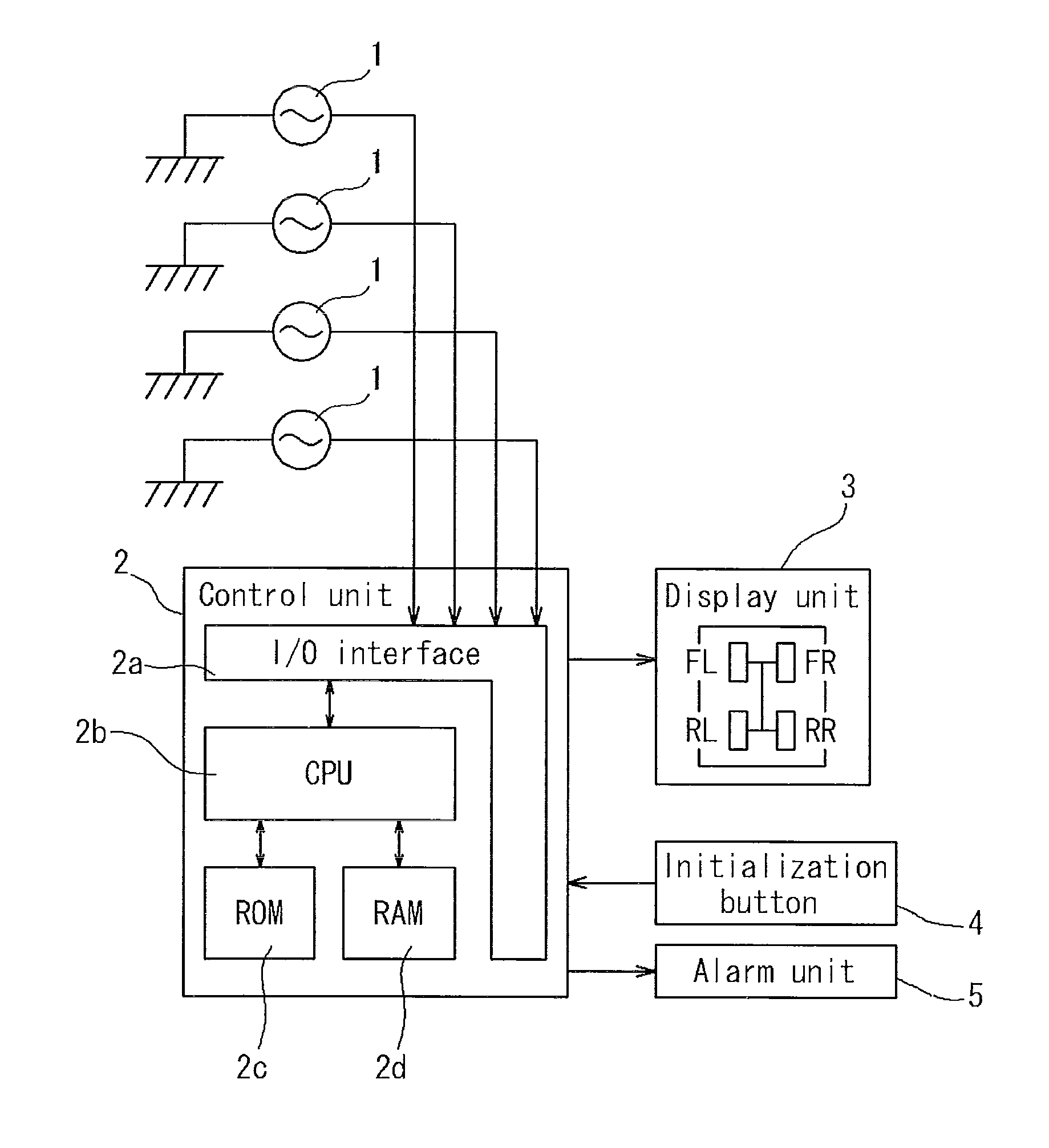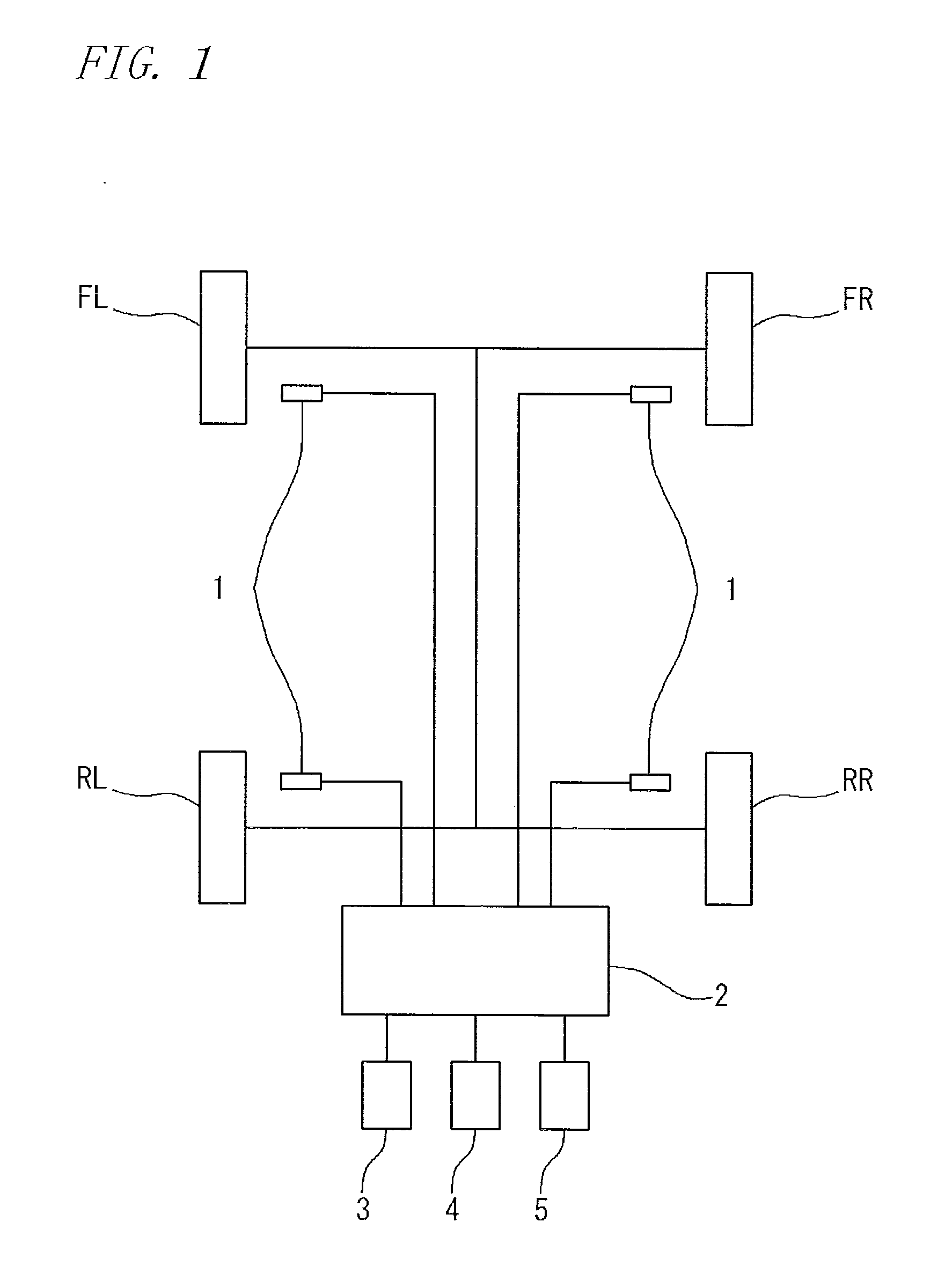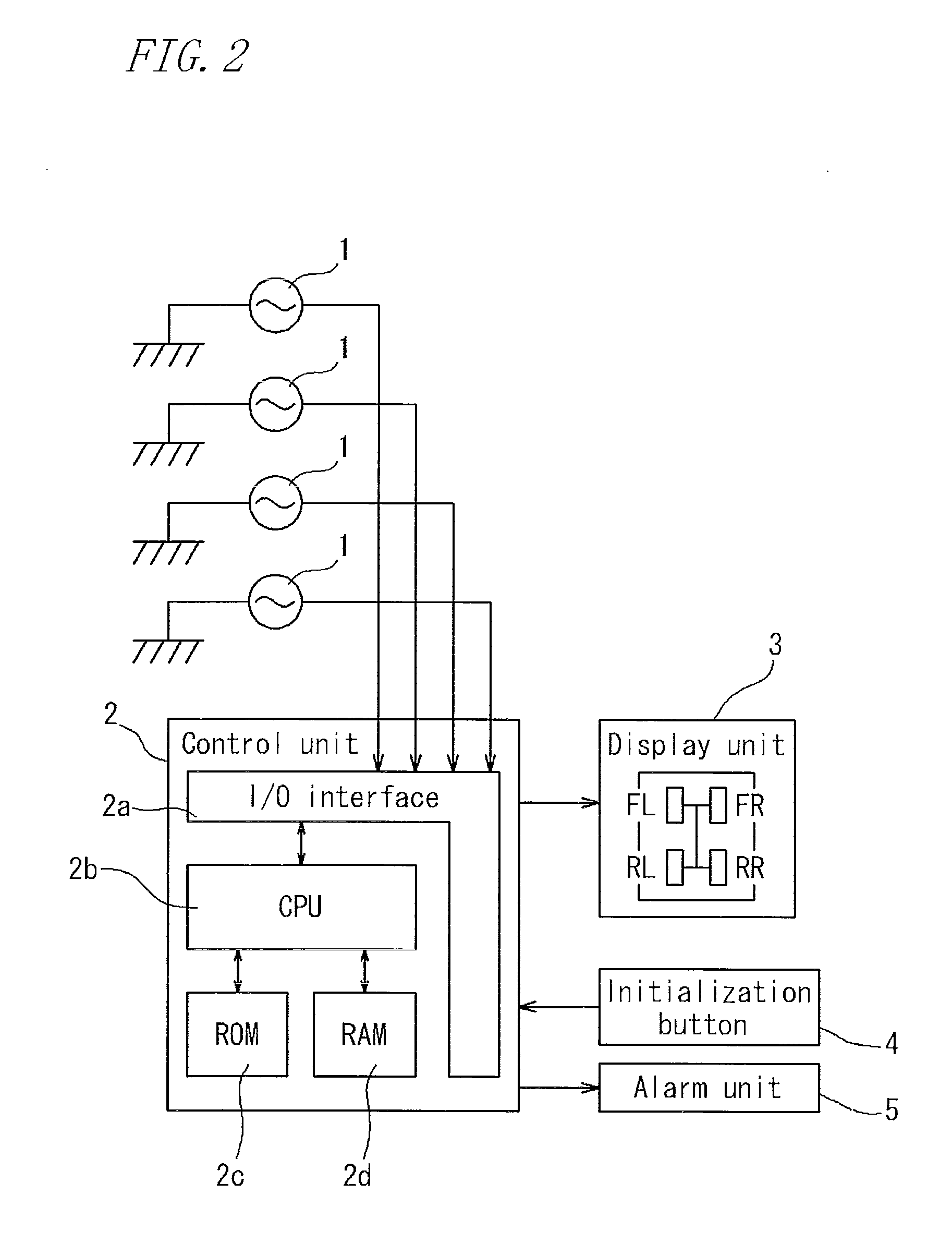Apparatus, method, and program for detecting rotation speed information, and apparatus, method, and, program for detecting tire having decreased pressure
a technology of rotation speed information and program, which is applied in the direction of fluid pressure measurement by mechanical elements, electric unknown time interval measurement, amplifier modification to reduce noise influence, etc., can solve the problem of inability to detect a case of four wheels simultaneous deflation, disadvantageous direct tpms in technical and cost aspects, and problem of fault tolerance performance in an actual environment. problem, to achieve the effect of accurate detection, accurate calculation, and reduced pressur
Active Publication Date: 2010-08-26
SUMITOMO RUBBER IND LTD
View PDF50 Cites 22 Cited by
- Summary
- Abstract
- Description
- Claims
- Application Information
AI Technical Summary
Benefits of technology
The present invention relates to an apparatus, method, and program for detecting tire rotation speed information to detect tires with decreased pressure. The invention uses the resonance frequency method, which detects a decrease in air pressure by analyzing the frequency of wheel speed signals obtained from a vehicle's ABS. The invention has advantages over other methods such as direct detection and indirect detection, including accuracy and cost-effectiveness. The invention can detect a decrease in air pressure caused by a puncture or a natural leakage of the tire. The technical effect of the invention is to provide a reliable and effective technique for detecting tires with decreased pressure to prevent accidents and promote driver safety.
Problems solved by technology
When the air pressure is lower than an appropriate value, the stable maneuverability or fuel consumption is deteriorated, which may cause a tire burst.
The direct TPMS can detect a decrease in the pressure at a high accuracy but requires exclusive wheels and has a problematic fault-tolerance performance in an actual environment for example.
Thus, the direct TPMS is still disadvantageous in the technical and cost aspects.
However, this method merely makes a relative comparison among wheel rotation speeds and thus cannot detect a case of four wheels simultaneous deflation (natural leakage).
Furthermore, a disadvantage is caused where a decreased pressure cannot be accurately detected through all running conditions because a difference in the wheel speed is also caused by running conditions such as the turning of the vehicle, the acceleration and deceleration, and an eccentric load.
However, the RFM method has a disadvantage where some running conditions cause strong noise for example and thus an estimated frequency value of a target domain is not robust against the vehicle speed and the road surface situation for example.
Thus, the RFM method focuses on this resonance frequency and issues an alarm when the frequency is relatively lower than a reference frequency estimated during initialization.
However, since it is difficult to store time-series data in an in-vehicle calculator having a limited calculation resource, a difficulty is caused in performing the frequency analysis based on FFT.
Thus, if this assumption cannot be satisfied due to a case in which the sampling cycle changes in accordance with the vehicle running speed for example, the frequency characteristic cannot be acquired correctly.
Firstly, when a cycle at which a dynamic wheel speed signal is obtained is, due to a low-speed running, longer than a sampling cycle, a plurality of wheel speed signals are extracted through a single interpolation. However, these wheel speed signals have thereamong only a simple linear relation, thus losing the tire vibration-related information originally included in the time information.
Secondly, dynamic wheel speed signals used as data for resampling are merely two neighboring points. This means that some obtained information is not used, causing a poor resampling accuracy. Non Patent Literature 1 suggests, as a method that can solve the disadvantage as described above, a method using a low-pass filter and the decimation of a resampled wheel speed signal. However, this method does not provide a fundamental solution to all conditions and also requires a large amount of calculation.
Therefore, this method is not practical.
In the case of this method however, as the speed is lower, the overlap is caused between the data used for the regression in order to calculate a wheel speed signal at a certain time and the data used for the regression in order to calculate a wheel speed signal at the next time.
Thus, a third disadvantage is newly caused.
Particularly under the running conditions having a speed of 40 kilometers or less per hour, the filter effect is strong and a high influence is also caused on the frequency band to which attention is paid for detecting an abnormality, which is not desirable.
However, any of these methods lacks in the physical basis and also provides a small effect to the required calculation amount and thus is insufficient as a method.
However, in the RFM method, such a simple calculation method cannot be applied due to the two reasons as described below.
Thus, the long sampling cycle of 40 milliseconds is far from satisfying the required performance.
Secondly, a sufficient accuracy required to acquire the frequency characteristic cannot be secured.
Thus, in the case of the calculation including such a rough part, the data accuracy is remarkably insufficient in the RFM method that must detect a minute change in the resonance frequency occurring on the order of a few Hz.
Furthermore, an influence by an error due to the approximate calculation of the accumulated time increases as the sampling cycle is shorter.
In order to solve the first disadvantage, it is not effective to simply reduce the sampling cycle.
The resampling method as described above has been recognized as being difficult for application because of the high calculation load.
Thus, no detailed examination or development has been performed for the resampling method.
Method used
the structure of the environmentally friendly knitted fabric provided by the present invention; figure 2 Flow chart of the yarn wrapping machine for environmentally friendly knitted fabrics and storage devices; image 3 Is the parameter map of the yarn covering machine
View moreImage
Smart Image Click on the blue labels to locate them in the text.
Smart ImageViewing Examples
Examples
Experimental program
Comparison scheme
Effect test
example 1
[0085]the resampling method of the present invention (based on the formula (2))
example 2
[0086]the resampling method of the present invention (based on the formula (4))
the structure of the environmentally friendly knitted fabric provided by the present invention; figure 2 Flow chart of the yarn wrapping machine for environmentally friendly knitted fabrics and storage devices; image 3 Is the parameter map of the yarn covering machine
Login to View More PUM
| Property | Measurement | Unit |
|---|---|---|
| speed | aaaaa | aaaaa |
| time | aaaaa | aaaaa |
| frequency | aaaaa | aaaaa |
Login to View More
Abstract
A rotation speed information detection apparatus, including: a wheel sensor for detecting passage of teeth of a gear provided in association with tires of a vehicle; a number-of-teeth calculation means for calculating the number of teeth of the gear passed per a sampling cycle set in advance; and a wheel speed calculation means for regularly calculating rotation speed information of the tire with using the number of teeth calculated. The number-of-teeth calculation means is configured to use a ratio between time information at the point and a remaining time until the time at which the next sampling cycle is started is reached to thereby calculate the number of remaining teeth to calculate the number of teeth passed during the sampling cycle. The wheel speed calculation means is configured to calculate tire rotation speed information based on an interval between neighboring teeth in the gear, the number of teeth passed during the sampling cycle, the number of remaining teeth calculated by the number-of-teeth-calculation means, and the sampling cycle.
Description
TECHNICAL FIELD[0001]The present invention relates to an apparatus, a method, and a program for detecting tire rotation speed information used for an apparatus or a method for detecting a tire having a decreased pressure for detecting, based on a resonance frequency of a tire of a running vehicle, a decrease in air pressure of a tire, and an apparatus, a method, and a program for detecting a tire having a decreased pressure using them.BACKGROUND ART[0002]One of factors required to allow an automobile to run safely is a tire air pressure. When the air pressure is lower than an appropriate value, the stable maneuverability or fuel consumption is deteriorated, which may cause a tire burst. Thus, Tire Pressure Monitoring System (TPMS) for detecting a tire having a decreased pressure to send an alarm to the driver to prompt an appropriate action is an important technique from the viewpoint of environment protection and driver safety.[0003]A conventional alarm apparatus can be classified ...
Claims
the structure of the environmentally friendly knitted fabric provided by the present invention; figure 2 Flow chart of the yarn wrapping machine for environmentally friendly knitted fabrics and storage devices; image 3 Is the parameter map of the yarn covering machine
Login to View More Application Information
Patent Timeline
 Login to View More
Login to View More Patent Type & Authority Applications(United States)
IPC IPC(8): G06F19/00G01P3/00B60C23/02B60C23/06G01L17/00G01P3/487G01P3/489
CPCG01P3/489B60C23/062
Inventor FUJITA, HAJIMEKAWASAKI
Owner SUMITOMO RUBBER IND LTD
Features
- R&D
- Intellectual Property
- Life Sciences
- Materials
- Tech Scout
Why Patsnap Eureka
- Unparalleled Data Quality
- Higher Quality Content
- 60% Fewer Hallucinations
Social media
Patsnap Eureka Blog
Learn More Browse by: Latest US Patents, China's latest patents, Technical Efficacy Thesaurus, Application Domain, Technology Topic, Popular Technical Reports.
© 2025 PatSnap. All rights reserved.Legal|Privacy policy|Modern Slavery Act Transparency Statement|Sitemap|About US| Contact US: help@patsnap.com



